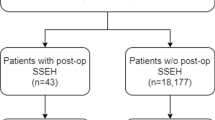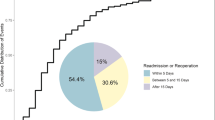Abstract
Purpose
Postoperative spinal epidural hematoma (PSEH) is one of the most hazardous complications after spine surgery. A recent study has reported that a ≥50 mmHg increase in systolic blood pressure after extubation was a significant risk factor for symptomatic PSEH. In this paper, the impact of hypertension on PSEH occurrence was investigated.
Methods
Among a total of 2468 patients who underwent single level microscopic posterior decompression surgery for lumbar spinal stenosis in a single institute, 15 (0.6%) received evacuation surgery for PSEH. Those 15 patients were investigated statistically compared with a randomly selected control group (n = 46) using the Mann–Whitney U test and multiple logistic regression analysis.
Results
The univariate analysis showed that there were no significant differences in age, gender, BMI, pre-operative anti-coagulant usage, intraoperative blood loss, operation time, and the rate of patients who received pre-operative hypertension treatment. However, there were significant differences in the rate of patients who showed high blood pressure at admission (66.7 vs 6.5%) and >50 mmHg increases in blood pressure after extubation (53.3 vs 17.4%) in the univariate analysis. Moreover, postoperatively, there was a statistical difference in the amount of post-operative drainage. Multiple logistic regression analysis showed that high blood pressures at admission and poor postoperative drainage were the essential risk factors.
Conclusions
Our results demonstrate that the pre-operative high blood pressure value was the most essential risk factor for PSEH, although there was no difference in the preoperative hypertension treatment. Consequently, management of pre-operative blood pressure and post-operative drainage will be crucial for preventing PSEH.


Similar content being viewed by others

References
Yonenobu K, Hosono N, Iwasaki M et al (1991) Neurologic complications of surgery for cervical compression myelopathy. Spine (Phila Pa 1976) 16:1277–1282
Ikuta K, Tono O, Tanaka T et al (2006) Evaluation of postoperative spinal epidural hematoma after microendoscopic posterior decompression for lumbar spinal stenosis: a clinical and magnetic resonance imaging study. J Neurosurg Spine 5:404–409. doi:10.3171/spi.2006.5.5.404
Glotzbecker MP, Bono CM, Wood KB, Harris MB (2010) Postoperative spinal epidural hematoma: a systematic review. Spine (Phila Pa 1976) 35:E413–E420. doi:10.1097/BRS.0b013e3181d9bb77
Lawton MT, Porter RW, Heiserman JE et al (1995) Surgical management of spinal epidural hematoma: relationship between surgical timing and neurological outcome. J Neurosurg 83:1–7. doi:10.3171/jns.1995.83.1.0001
Yamada K, Abe Y, Satoh S et al (2015) Large increase in blood pressure after extubation and high body mass index increase the risk of spinal epidural hematoma after spinal surgery. Spine (Phila Pa 1976). doi:10.1097/BRS.0000000000000876
Amiri AR, Fouyas IP, Cro S, Casey ATH (2013) Postoperative spinal epidural hematoma (SEH): incidence, risk factors, onset, and management. Spine J 13:134–140. doi:10.1016/j.spinee.2012.10.028
Modi HN, Lee DY, Lee S-H (2011) Postoperative spinal epidural hematoma after microscopic lumbar decompression: a prospective magnetic resonance imaging study in 89 patients. J Spinal Disord Tech 24:146–150. doi:10.1097/BSD.0b013e3181e1958e
Awad JN (2005) Analysis of the risk factors for the development of post-operative spinal epidural haematoma. J Bone Jt Surg Br 87-B:1248–1252. doi:10.1302/0301-620X.87B9.16518
Kao F-C, Tsai T-T, Chen L-H et al (2015) Symptomatic epidural hematoma after lumbar decompression surgery. Eur Spine J 24:348–357. doi:10.1007/s00586-014-3297-8
Sumida T, Manabe H, Kobayashi K et al (2007) Semi-circumferential decompression (SCD): microscopic posterior decompression for lumbar spine. J Jpn Soc Spine Surg Relat Res 18:662–664
Fujiwara Y, Manabe H, Sumida T et al (2017) Facet preserving technique by en bloc flavectomy in microscopic posterior decompression surgery for lumbar spinal stenosis semicircumferential decompression (SCD). Clin Spine Surg. (In publish)
Aono H, Ohwada T, Hosono N et al (2011) Incidence of postoperative symptomatic epidural hematoma in spinal decompression surgery. J Neurosurg Spine 15:202–205. doi:10.3171/2011.3.SPINE10716
Goldstein CL, Bains I, Hurlbert RJ (2015) Symptomatic spinal epidural hematoma after posterior cervical surgery: incidence and risk factors. Spine J 15:1179–1187. doi:10.1016/j.spinee.2013.11.043
Kou J, Fischgrund J, Biddinger A, Herkowitz H (2002) Risk factors for spinal epidural hematoma after spinal surgery. Spine (Phila Pa 1976) 27:1670–1673
Sokolowski MJ, Garvey TA, Perl J et al (2008) Prospective study of postoperative lumbar epidural hematoma: incidence and risk factors. Spine (Phila Pa 1976) 33:108–113. doi:10.1097/BRS.0b013e31815e39af
Mirzai H, Eminoglu M, Orguc S (2006) Are drains useful for lumbar disc surgery? A prospective, randomized clinical study. J Spinal Disord Tech 19:171–177. doi:10.1097/01.bsd.0000190560.20872.a7
de Simone G, Devereux RB, Chien S et al (1990) Relation of blood viscosity to demographic and physiologic variables and to cardiovascular risk factors in apparently normal adults. Circulation 81:107–117
Payne DH, Fischgrund JS, Herkowitz HN et al (1996) Efficacy of closed wound suction drainage after single-level lumbar laminectomy. J Spinal Disord 9:401–403
Brown MD, Brookfield KFW (2004) A randomized study of closed wound suction drainage for extensive lumbar spine surgery. Spine (Phila Pa 1976) 29:1066–1068
Kanayama M, Oha F, Togawa D et al (2010) Is closed-suction drainage necessary for single-level lumbar decompression? Review of 560 cases. Clin Orthop Relat Res 468:2690–2694. doi:10.1007/s11999-010-1235-6
Acknowledgements
We appreciate Mr. Vincent Hykel for his devoted support.
Author information
Authors and Affiliations
Corresponding author
Ethics declarations
Conflict of interest
The authors declare that they have no competing interest.
Rights and permissions
About this article
Cite this article
Fujiwara, Y., Manabe, H., Izumi, B. et al. The impact of hypertension on the occurrence of postoperative spinal epidural hematoma following single level microscopic posterior lumbar decompression surgery in a single institute. Eur Spine J 26, 2606–2615 (2017). https://doi.org/10.1007/s00586-017-5165-9
Received:
Revised:
Accepted:
Published:
Issue Date:
DOI: https://doi.org/10.1007/s00586-017-5165-9



